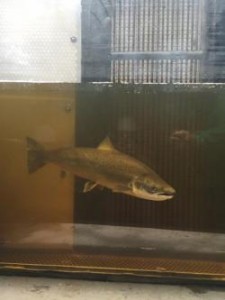Safety First on the Ice
Ice fishing safety is critical
from The Fishing Wire
Thanks to an extended stretch of unusually mild weather, anxious anglers across the Ice Belt are starting to venture out on winter’s magic carpet in force.
But even at this late date, ice conditions are far from perfect. In some areas, warm weather is weakening the fledgling icepack, while in others, fresh snow is cloaking it with an insulating blanket that puts the brakes on the formation of new ice.
“Safety is always a concern when ice fishing, but it’s more important now than ever,” reports veteran ice fishing guide Bernie Keefe of Granby, Colorado.
Keefe is quick to point out that weather changes can wreak havoc on a lake’s icy coating, which otherwise is some of winter’s strongest ice. “You can throw the ice thickness charts for new ice out the window once you get a prolonged thaw, rain or even thick, wet snow,” he says.
Indeed, above-freezing temperatures can greatly reduce the ice’s strength-to-thickness ratio. For example, while four inches of fresh, clear ice may support a person on foot, a foot or more of rotting, partially thawed ice may not.
That’s not to say all ice is unsafe right now. Keefe is out and about chasing lakers and other salmonids on his high-country home waters, and similar opportunities exist across the north. But he strongly advises taking ample precautions to help prevent accidental dunkings and avert tragedy if someone does fall through.
“Your first step in ice safety should be researching the conditions with local guides, bait shops and other reliable sources of information,” he says. “Facebook is a helpful tool, too, as are online forums.”
While such homework can steer you toward lakes with traversable ice, Keefe cautions that it’s just a starting point. “A smart plan of attack and the right safety gear are still critical,” he says.
For starters, Keefe never fishes alone on first ice. And he always lets someone back on shore know where he’s headed and when he plans to return.
A variety of safety gear including a spud bar, ice cleats, Nebulus floatation system and emergency rescue line can help avoid tragedy on ice.
He also arms himself with a variety of life-saving devices that starts with his wardrobe. “I always wear a Clam IceArmor LIFT Suit,” he says, explaining that the built-in Space Age lining boosts buoyancy without adding bulkiness. “You don’t even know you’re wearing a buoyant suit,” he adds.
Along with the suit, he slips heavy-duty yet lightweight Kahtoola ice cleats over his boots to assure traction on the treacherously slippery surface. “Cleats are a must, especially on slick new ice, or when you splash water onto the ice when drilling or landing fish,” he notes.
Keefe also slips the nylon tether linking a pair of Clam Floating Ice Picks around his neck, and stashes one of the company’s 50-foot Emergency Throw Rope rescue lines in his sled.
“The rescue line is easy to throw to someone in trouble,” he says. “I also pull my sled with a 50-foot rope, which provides added insurance. When walking out on the ice, I hold the line and my fishing partner stays next to the rope a safe distance away from me, so if either one of us goes in, the other one can haul him out.”
Unloaded, the sled also serves as a handy rescue device in its own right. “Just dump everything out and slide it over to a person who’s fallen through,” he adds.
As added insurance, Keefe also carries a Nebulus Emergency Flotation Device, which when inflated can support the weight of three adults plus a submerged snowmobile or ATV.
By doing his homework and gearing up with the right safety equipment, Keefe is safely enjoying the early winter bite, and so can you, provided you take similar precautions to ensure your well being on the ice as the unusual winter of 2015-’16 gets rolling.
Check out this video for more ice safety tips from Bernie.
CONTACT INFORMATION
For more information or to book a trip with Keefe, visit: www.fishingwithbernie.com
or call (970) 531-2318.





